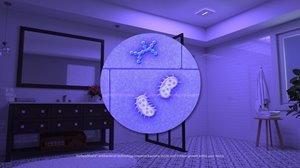5 Things You Can do in Your Home
to Reduce Exposure to COVID-19
Collectively, we’ve learned a lot about the air we breathe. 2020 made us really think about how we conduct our lives from how often we wash our hands – and for how long – to how close we stand next to someone. We fret over how tall our office cubicle walls are and how close we’re standing next to our coworker as we get our jobs done. We’re very conscious of the large spaces and buildings – like the schools and offices we inhabit – because we’ve been told to keep our distance. But what about our homes? This is our pod of people, right? It’s our home, it must be a safe harbor, right?

We should feel safe in our homes but, as we’ve learned, there are invisible threats lurking there too. The viruses, bacteria, and other germs don’t stop at our door. And, unfortunately, no amount of cleaning will wipe them out. Sure, they’re on surfaces and you can take care of them there, but they are still in our air.
According to the CDC’s May 7th, 2021 update, improving your home’s ventilation is one of the tools you can use to reduce your exposure to the virus that causes COVID-19. “Modes of SARS-CoV-2 transmission are now categorized as inhalation of virus, deposition of virus on exposed mucous membranes, and touching mucous membranes with soiled hands contaminated with virus. Although infections through inhalation at distances greater than six feet from an infectious source are less likely than at closer distances. These transmission events have involved the presence of an infectious person exhaling virus indoors for an extended time (more than 15 minutes and in some cases hours) leading to virus concentrations in the air space sufficient to transmit infections to people more than 6 feet away, and in some cases to people who have passed through that space soon after the infectious person left.” Per published reports, factors that increase the risk of COVID-19 infection under these situations include:
- Enclosed spaces with inadequate ventilation or air handling within which the concentration of exhaled respiratory fluids, especially very fine droplets, and aerosol particles, can build-up in the air space.
- Increased exhalation of respiratory fluids if the infectious person is engaged in physical exertion or raises their voice (e.g., exercising, shouting, singing).
- Prolonged exposure to these conditions, typically more than 15 minutes.

Here's a list of 5 things you can do to reduce the concentration of the virus and other pollutants in your home:
- Increase the amount of fresh air you bring into your home. This can be accomplished by opening windows when possible, but that isn’t always the best option. Allergies, smoke, and inclement weather all make opening windows often impossible. A great way to provide a constant supply of fresh air to your home is to install a Fresh Air System. A simple supply fan can work, or you can have balanced ventilation unit – such as an Energy Recovery Ventilator – installed that both brings in fresh air and removes old, polluted air.
- Run your ventilation fans. At the very least, you probably have a bath fan in your home that exhausts to the outside. You may also have a range hood that exhausts to the outside. Whatever you have, make sure you run them often. Today’s bath fans are quiet and very energy efficient. You can even find some fans that are meant to be run continuously at a low speed and so quiet you’ll forget it’s on (they’re energy efficient too).
- Clean out your ventilation system’s filters. Make sure you’re replacing your furnace/AC filter as recommended. Clean the filters on your range hood and look at your bath fan to make sure the cover is clean and that there isn’t any buildup of dust on the fan. If the cover has seen better days you can upgrade to a clean one that has a light or maybe a Bluetooth® speaker.
- Increase air flow in the home. Many air handlers (the fan that works with your furnace and AC) have the ability to run for a pre-set minimum number of minutes each hour. Consider turning on that option or increasing the number of minutes that fan runs.
- Install an anti-bacterial bath fan. We offer a product called SurfaceShield™ that kills COVID and prevents the growth of bacteria, mold, mildew, and yeast. The purple light in our SurfaceShield™ exhaust fans causes these invaders to die off but is completely harmless to humans and pets. This a very powerful tool in fighting COVID along with other bacteria, mold, and mildew that can cause illness and allergic reactions. That, coupled with the impressive ventilation the fan provides, provides a strong defense for your home.

 English
English
 English
English